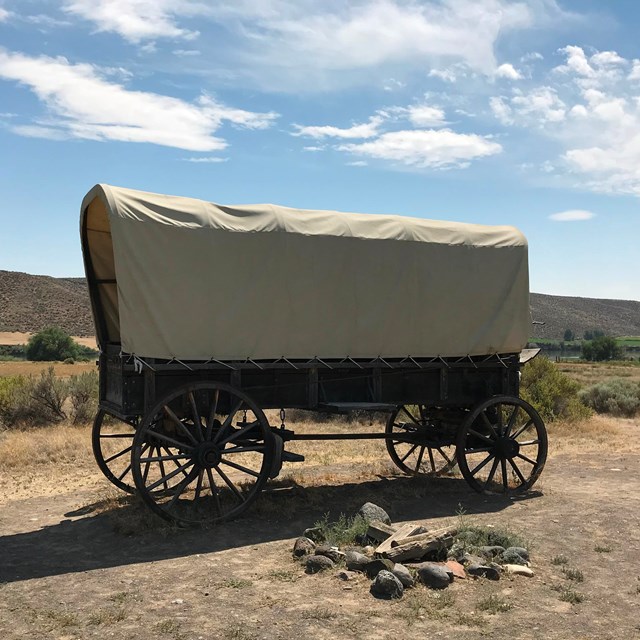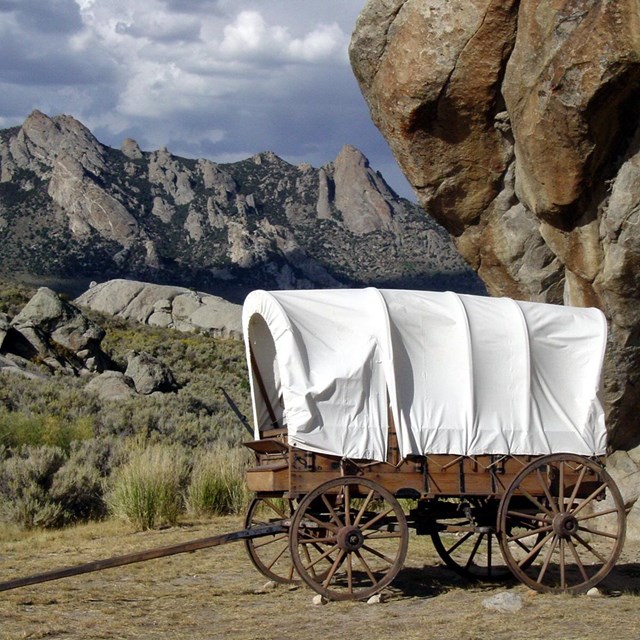Last updated: March 28, 2022
Article
Chapter 1: Race, Slavery, and Freedom - The Evolution of Their Status
Sweet Freedom's Plains
African Americans on the Overland Trails 1841-1869
By Shirley Ann Wilson Moore, PhD.
For the National Park Service
National Trails Regions 6, 7, & 8
Introduction/Table of Contents
Chapter 1 Sections
- The Early Black Presence
- The Question of Race
- The Evolution of Their Status
- The Contagion of Liberty
- Permanent, Hereditary Chattel: A Snapshot of Antebellum Slavery in the South, Indian Territory, and Border States
- Northern “Unfreedom”
- The Nature of Freedom in the West
- Utah: Slaves and Saints
- No Rights to be Respected
The transformation of the status of black men and women occurred as European settlement of North America increased and the demand for labor rose. By the time of the great overland migrations, black people lived within a political and social context that had been established to deny them their humanity, restrict their liberty, and frustrate their aspirations. The racially restrictive environment in which black western emigration took place evolved over a relatively short period of time and was influenced by a number of economic, social, and political factors.
In the seventeenth century, when the British established colonies in North America, people of African descent were among the first settlers, arriving as slaves, indentured servants, or free people. Although historians continue to debate the legal status of the first black arrivals in the colonies, black residents and white indentured servants alike often shared the same state of “half freedom.”17 In many cases, blacks’ status was indistinguishable from that of white indentured servants. Until the mid-seventeenth century, a number of black colonists were able to benefit from permeable racial boundaries that often allowed them to successfully petition for freedom, purchase their liberty, and own property.18
Nonetheless, census records and other documents show that white colonists routinely differentiated between themselves as “Englishe” and blacks as “Negroes,” and black colonial residents experienced different treatment than their white counterparts.19 Whites often identified blacks arriving in the colonies not by name (as was the case for white arrivals), but by color, age and sex—as they might identify horses or cattle. Field labor was assigned routinely to black servant women, while indentured white women generally worked around the home. Typically, white indentured servants who ran away were punished with extra time added to their terms of labor. However, as early as 1640, captured black runaway servants in Virginia were being sentenced to lifetime servitude.20
As the cultivation of lucrative staple crops like tobacco and rice expanded and began to drive colonial economies, the demand for a permanent labor source increasingly targeted Africans and their descendants. The ambiguous racial status of the earlier period hardened into a system of chattel slavery that cast people of African ancestry into permanent, hereditary bondage.21 By the mid-seventeenth century, chattel slavery had become a visible presence in all thirteen colonies, and it dominated race relations in the colonial era.
Next Section - Chapter 1, Race Slavery Freedom: The Contagion of Liberty
17 Winthrop D. Jordan, “Modern Tensions and the Origins of American Slavery,” The Journal of Southern History 28, no. 1 (February 1962): 20.
18 For a discussion of black colonists successfully gaining freedom, see Warren M. Billings, “The Case of Fernando and Elizabeth Key: A Note on the Status of Blacks in Seventeenth-Century Virginia,” William and Mary Quarterly, Third Series, 30, no. 3 (July 1973): 467-474, especially 471-473; and Darlene Clark Hine, William C. Hine, and Stanley Harrold, The African American Odyssey, combined 4th ed. (Upper Saddle River, N.J.: Prentice Hall, 2010), 60. For a discussion of similarities between white indentured servants and blacks, see Lois E. Horton, “From Class to Race in Early America: Northern Post-Emancipation Racial Reconstruction,” Journal of the Early Republic 19, no. 4, (Winter 1999): 562-649, especially 630-631.
19 Quotes from Jordan, “Modern Tensions and the Origins of American Slavery,” 22.
20 For a detailed discussion of the distinctions white colonists drew between themselves and black colonists, see Jordan, “Modern Tensions and the Origins of American Slavery,” 22-23. Jordan notes that the John Punch incident of 1640 was the first “definite indication of outright enslavement” in any English colony. In this case, the General Court of Virginia punished an interracial group of indentured servants who had run away and were recaptured. The two white men were ordered to serve their masters for an additional year, and the colony for three more. John Punch, the black runaway in the group, was sentenced to “serve his said master or his assigns for the time of his natural life.” Later that same year in Virginia, a band of seven runaways was apprehended. This time, six white men in the group were sentenced to additional years of service, but the lone black man in the party received none. Jordan speculates this was because he was already serving for life. See Jordan, White Over Black , 75. For the status of blacks in the early British colonies, see Hine et al., The African-American Odyssey, 53-54, and 59 for the account John Punch and the treatment of black and white runaways. Also see John Hope Franklin and Alfred A. Moss, Jr., From Slavery to Freedom: A History of African Americans, 7th ed. (New York: McGraw Hill, 1994), 56-61; Russell R. Menard, Migrants, Servants and Slaves: Unfree Labor in Colonial British America (Aldershot, United Kingdom: Ashgate, 2001); and Billings, “The Case of Fernando and Elizabeth Key,” 467-474.
21For a detailed examination of the transformation of the status of black people from ambiguous status to chattel property during the colonial period, see Jordan, White over Black; Edmund S. Morgan, American Slavery, American Freedom: The Ordeal of Colonial Virginia (New York: Norton, 1975); Peter H. Wood, Black Majority: Negroes in Colonial South Carolina, from 1670 through the Stono Rebellion (New York: Knopf, 1974); Joanne Pope Melish, Disowning Slavery: Gradual Emancipation and “Race” in New England, 1780-1860 (Ithaca: Cornell University Press, 1998); Ira Berlin, Many Thousand Gone: The First Two Centuries of Slavery in North America (Cambridge: Belknap Press of Harvard University Press, 1998).




